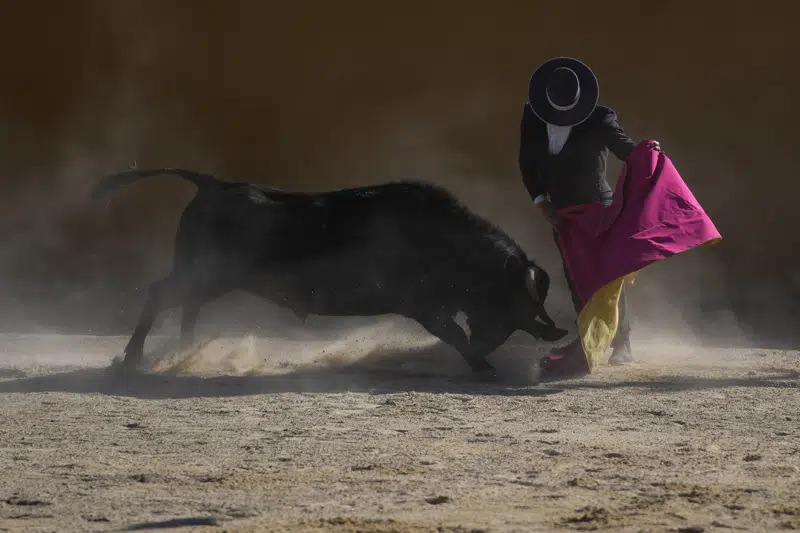
A 61-year-old matador nicknamed “Little gypsy of America” fell headfirst into the dust when he was headbutted by a bull. He recovered to the applause of the crowd, and later killed the bull with a sword thrust to the back of its neck.
He was among six veteran bullfighters performing for free on a recent Saturday in front of about 150 people at an emerald-green hacienda in Colombia’s Andes. The festival was to raise money for a foundation hoping to save the centuries-old tradition from a national ban being pushed by politicians who argue bullfighting is cruel and unethical.
“Colombia’s art and culture must endure,” the matador, Jelain Fresneda, said after the difficult bout, shaking dust off his tight-fitting suit. “We need to ensure our freedoms are respected.”
Colombia is one of just eight countries where bullfights are still legal.
But the tradition has taken some blows around the world recently with courts and municipal governments in cities like Barcelona, Medellin and Mexico City issuing rulings that have discouraged the events.
Colombia’s Senate approved a nationwide ban in December. The House of Represenatives — which narrowly voted down an earlier ban in November — could take up the latest legislation in coming weeks when it returns from its three-month recess.
It will be a closely followed vote in Colombia, where bullfights have been held since colonial times but where public sentiment has shifted against the practice over ethical considerations as has happened elsewhere in the world.
“We are talking about living and feeling beings” said Andrea Padilla, a recently elected senator and longtime animal rights activist who drafted the anti-bullfighting law.
“These are mammals with a nervous system that enables them to feel pain and suffering with the same intensity as humans … and who shouldn’t be exposed to a slow and painful death.”
Padilla’s law proposes banning all bullfights within three years. It also says that bullfights should be adjusted immediately so that the animals aren’t killed in arenas or attacked with pikes and handheld harpoons called banderillas.
Bullfighting aficionados say those measures would effectively end the tradition, where the bull is fought and taunted in three stages that last about six minutes each. First, a horseman injures the bull with a long pike. Then, quick-footed assistants rush up to the bull to push sharp harpoons into the animal’s upper back. Lastly, the bull is finished off with the matador’s sword.
Supporters of bullfights say the ban would obliterate an art form, deprive rural residents of a popular entertainment, and deny livelihoods to street vendors at bullfights. They also argue that politicians like Padilla are trying to impose their beliefs on others.
“Almost every bovine that has been raised by man ends up in a slaughterhouse” said Gonzalo Sanz de Santamaria, a bull breeder who attended the recent festival at the Andean town of Villapinzon, about a two-hour drive northeast of Bogota.
“But the bull dies in a temple, admired, applauded, showing its bravery and fighting for its life.”
Santamaria is a fourth generation breeder and director of the Cultural Freedom Foundation, a group that supports bullfights, cockfights, rodeos and other traditional events that involve animals.
Santamaria said that for breeders like himself bulls are like “gods” that are bred with utmost care in free range pastures, where they are “admired and venerated.”
Surveys suggest bullfighting aficionados like Santamaria are a small share of Colombia’s population. In a November poll by Datexco, 85% of Colombians said they agreed with a ban on bullfights, while 13% said they were against plans to ban the tradition.
However, in Colombia’s House of Representatives many politicians have been reluctant to vote against bullfights. In November a bullfighting ban presented by congressman Juan Carlos Losada was rejected by a narrow margin of just three votes, with some lawmakers saying they preferred a bill that “moderates” bullfights by making some of the weapons used in these events less invasive.
In some parts of Colombia, like the city of Manizales, bullfights still draw thousands of spectators each year. The bullfighting ring in that city is owned by the local chapter of the Red Cross, and the city’s annual bullfighting festival generates thousands of dollars for a childrens’ hospital.
“It’s sad that people who don’t know anything about our sector want to make laws about us,” said Sergio Alzate, 22, an aspiring matador and pupil at the city’s bullfighting school.
Still, Sen. Padilla and thousands of others in Colombia argue that there is no ethical justification for events where animals are killed for entertainment.
“Any society that wants to advance in non violence, in peace and in respect for life, needs to ban these cruel spectacles,” Padilla said. She added that her bill directs the government to help create new sources of income for people working in bullfights.
Some advocates are focused on the future of Colombia’s herd of fighting bulls, whose market value would plummet after a ban, forcing many breeders to sell them to slaughterhouses.
Miguel Aparicio, a businessman who runs a shelter for farm animals outside Bogota says he’s already received eight young bulls from breeders who are downscaling their operations as the number of bullfights in Colombia decreases.
He said that bull breeding farms should consider reinventing themselves as ecotourism sites or sanctuaries for fighting bulls, so that people can enjoy these animals without seeing them killed.
“Just banning bullfights isn’t going to protect the bulls” Aparicio said. “We need to find a solution that looks out for the interests of these animals.”
– Manuel Rueda, AP News

